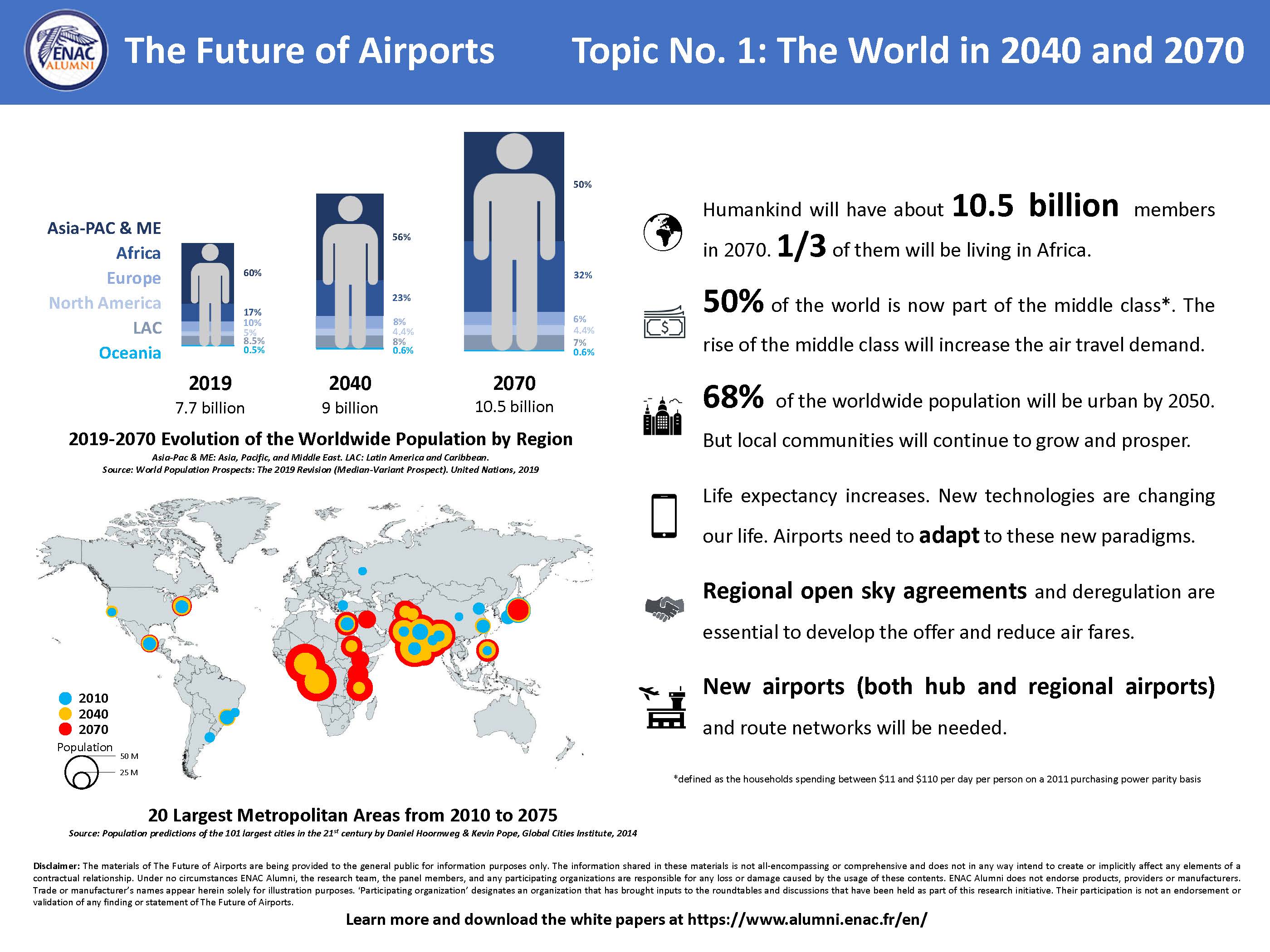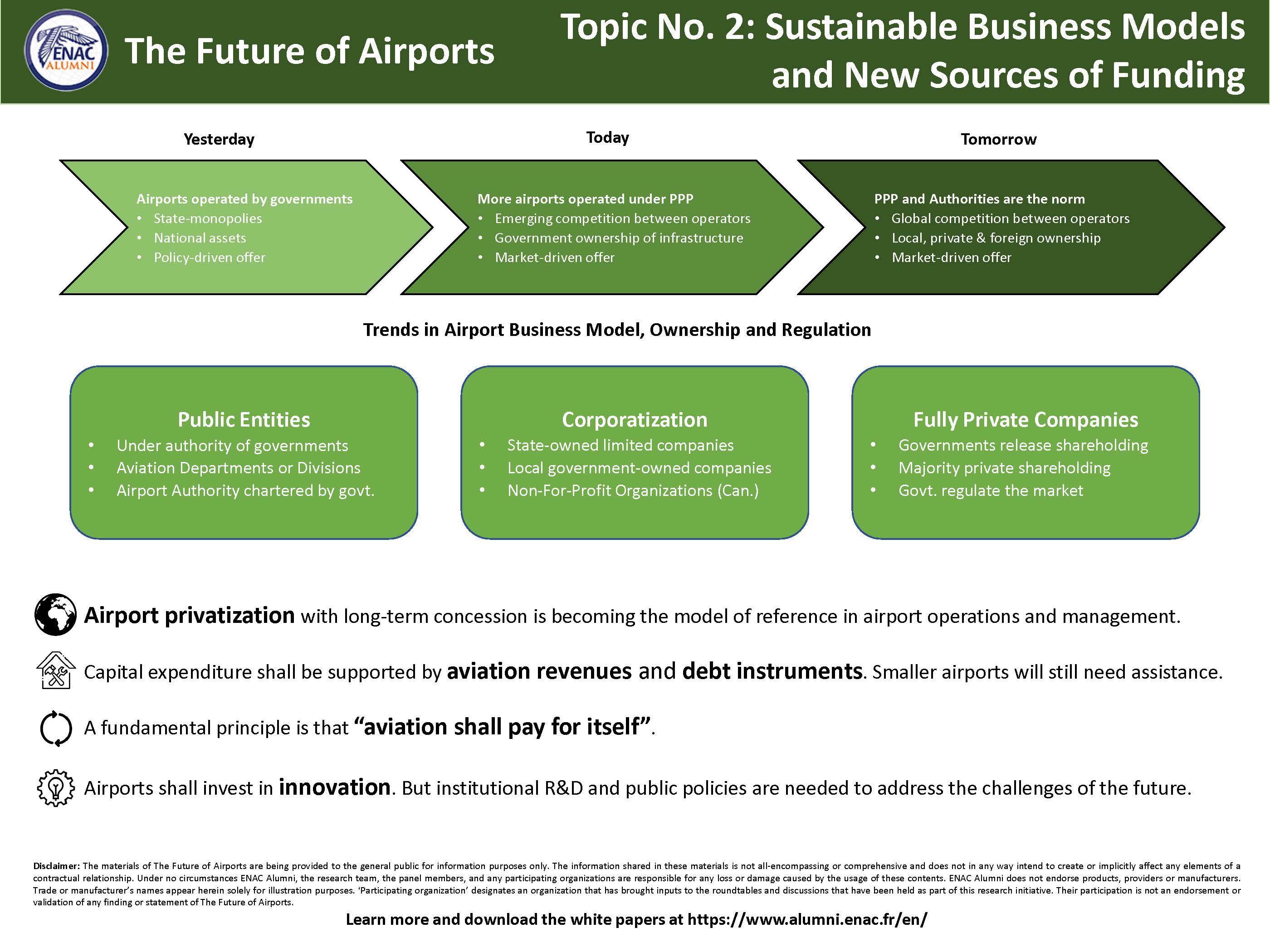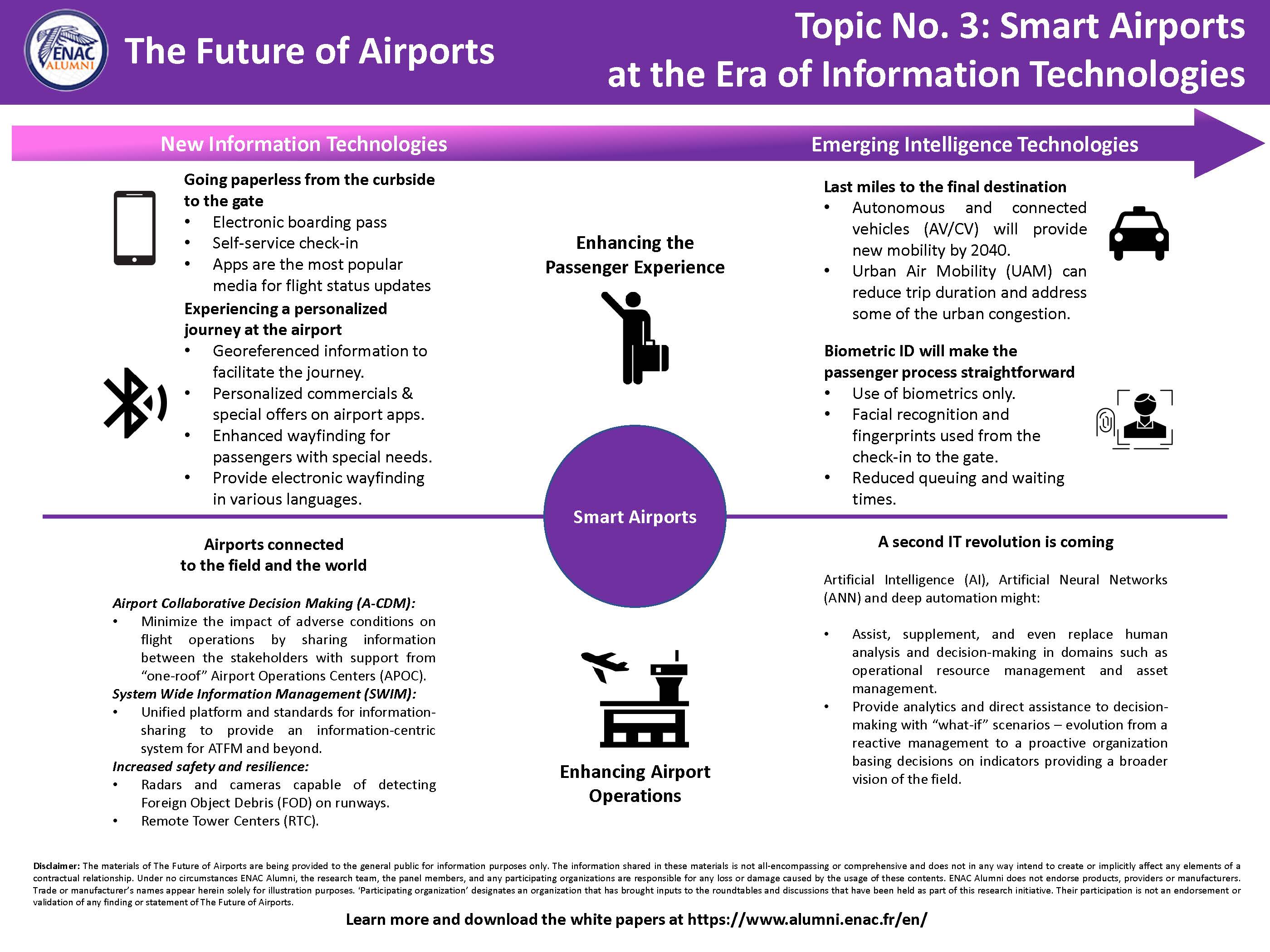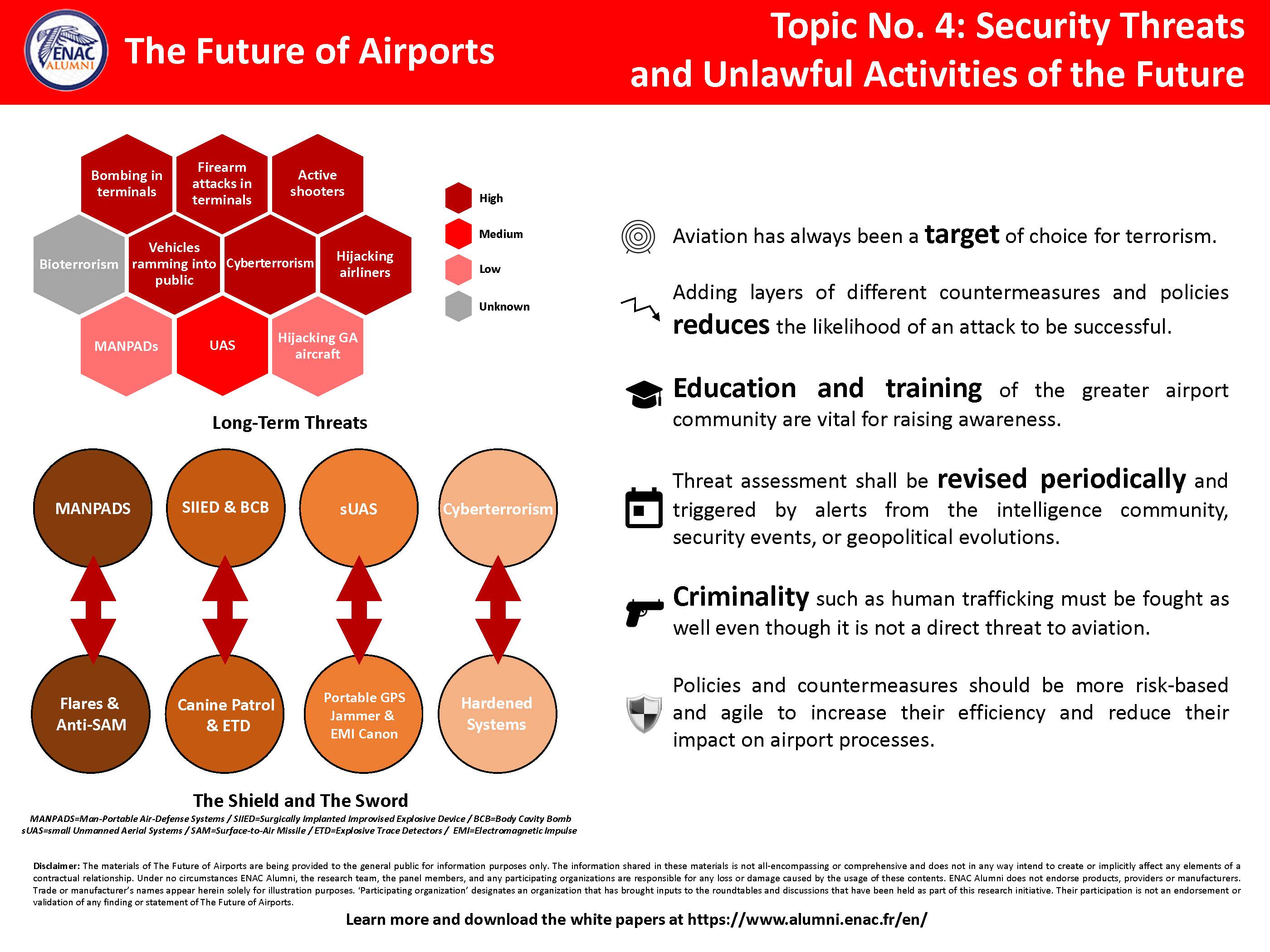Summary of Findings
The white papers and posters of the first four topics are available in the section Publications.
![]() Topic No. 1: The World in 2040 and 2070
Topic No. 1: The World in 2040 and 2070
There will be around 9 billion human beings in 2040, and then 10.5 billion in 2070. Most of this growth will occur in Asia and Africa. In the meantime, living conditions in the emerging and underdeveloped regions will improve. This might lead to a dramatic increase in the air travel demand that will call for new airports and more regional integration. After Europe, Africa (SAATM) and southeast Asia (ASEAN-SAM) are on their way to becoming the next single aviation markets.
About 68% of the worldwide population will live in urban areas in 2050. The growth of megalopolis will create challenges in mobility but also give birth to new aviation megacities. The large footprint of megacities and the congestion on the ground might promote multi-airport systems and secondary airports. Smaller and rural communities could revive or grow with people looking for another way of life. Local airports will continue to play a vital role in connecting them to the world.
Wages are increasing in developing countries. Carbon taxes on transportation are in discussion. Producing on the other side of the world is not as profitable as it was. Workers of western nations ask for relocating production and jobs. A growing number of consumers buy locally and call for a circular economy. The relocalization of the production of goods and its decentralization to more local sites fostered with a revolution in tooling and industrial processes (e.g. 3D printing) can deeply impact air cargo.
Life expectancy is improving worldwide. The population will continue to include a growing number of elders, healthier and wealthier than their forefathers. Children born after 2000 are growing up with information technologies. Hyperconnected, the communities of 2040 and furthermore 2070 will not have the same notion of time and space. Future airports will have to address and reconcile these different needs.
The correlation between human activities and global warming has been widely documented. Current policies and effective actions around the world are mostly behind the goals set in 2015 under the Paris Agreement. Facing the most challenging threat of human history, the aviation industry will continue its unprecedented effort to lower its environmental footprint. While the best warming is the one that we do not generate, airports will have to adapt to emit less, but also to be more resilient against climate change.
![]() Topic No. 2: Sustainable Business Models and New Sources of Funding
Topic No. 2: Sustainable Business Models and New Sources of Funding
During most of the 20th century, airports were planned, built and operated by central governments as tools of sovereignty, prestige, national defense, and territorial development. In the context of growing ancillary activities and capital expenditure, they were then turned into organizations created for operating airports often with a private corporation status and state-ownership. This move toward more independence promotes a culture of efficiency and a strategic vision, establishes the autonomy of decision from other governmental priorities, and enables an autonomy of the governance itself from political agendas as well.
Airport privatization might be seen as the next step of state-owned corporatization. There are privatization projects in all the regions of the world – and they take different forms. Public control of airport management is no more a necessity for national interests, and private operators are considered as more versatile, cost-efficient and innovative. Therefore, governments can focus on their role of market regulator and safety/security oversight.
Commercial service airports shall be allowed to adequately fund infrastructure maintenance and realistic development through their charges as they can no longer rely on direct public funding. Airport concessions and other PPP shall ensure benefits for both sides, and a fair distribution of profit and financial burden as well. High expectations on infrastructure development from governments that are not consistent with the actual level of traffic can challenge the financial viability of airports requiring vast capital improvements.
These considerations do not necessarily apply to smaller airports. Their financial equilibrium is more often precarious. While some of them might not appear as profitable, their impact on the local economy and connectivity has to be considered too. Several remote aviation facilities providing vital access to the world for air taxi, air ambulance, and subsidized air routes will remain public and require direct funding from local governments or national programs. They cannot be profitable and are not intended to do so.
Several programs exist around the world to ensure airports are safely developed and meet the needs of the nations. Their form and extent depend on the size of airports and the local specificities. These funds usually exclude the terminal facilities from grants. To rejuvenate and develop them, State and regional investment banks can lend money at a lower interest rate as long as the operator is based in the country. In every case, airport operators and governments shall carefully balance the opportunities created by these projects and the level of risk and sustainable debt ratio.
The fundamental principle is that “aviation shall pay for itself”. Indeed, direct injection of public money coming from the general budget of a state raises legitimate questions on national priorities – especially when projects are not profitable nor necessarily justified from a social profit perspective. Concessions to private operators of infrastructure developed with public money raise also the question of a fair return on investment to governments.
Investing in innovation is crucial not only for the industry but for the air transportation ecosystem entirely. Some larger airport operators have the ambition to be leaders in innovation. However, the groundbreaking trends and transformational changes explored in the next topics (e.g. automation in air traffic management, cybersecurity, etc.) require wider efforts supported by national policies and funding.
![]() Topic No. 3: Smart Airports at the Era of Information Technologies
Topic No. 3: Smart Airports at the Era of Information Technologies
The information technology revolution in the passenger journey is already here. Passengers are exchanging data with and get personalized information from airlines and airports via their smartphones. These connected technologies provide georeferenced information and can facilitate the journey through large hub airports, improving accessibility to travelers with difficulties. In return, these tools of the Internet of Things (IoT) provides to the airport operator and other stakeholders with precious information on passenger flows.
Airports and air carriers have deployed facial recognition to simplify to expedite the process at the gate and minimize the boarding time. By 2040, biometrics will be available at other steps of the passenger journey. Fingerprints and facial identity might be the future “keys” to your flight. At the medium-term horizon, these solutions will reduce waiting times and will increase the automation of control and identification processes from the curbside to the gate, along with other technologies such as the self-service bag drop-off kiosks.
Continuing the digitalization of information initiated with Airport Geographical Information Systems (AGIS), Airport Building Information Modelling (ABIM) will open a new perspective to asset management and airport operations. Remote Tower Centers (RTC) will increase safety at airports with low-intensity traffic that are or might become non-towered, or with AFIS only. The technologies developed for the RTC might bring augmented reality enhancing air traffic control, increasing safety and resilience at “conventional” towers.
The need to increase punctuality and minimize the impact of adverse conditions on flight operations led to Airport Collaborative Decision Making (A-CDM). This concept relies on information sharing between the stakeholders of the real-time status of each flight. The extension of CDM concepts to the whole airport is called Total Airport Management (TAM), and it is supported by integrated Airport Operations Centers (APOC). At a broader scale, the System Wide Information Management (SWIM) will provide unified platforms and standards for information-sharing with a single point of access to ATFM data.
The collection and treatment of such volumes of data require adequate standards and infrastructure for supporting their transfer and storage. Most commercial airports have now data centers. They will be fed by the Internet of Things (and ultimately the Internet of Everything). Emerging means and processes to analyze data are dramatically expanding the horizon of possibilities. Machine learning and artificial intelligence can extract patterns and trends from Airport Operations Data Bases (AODB) for planning, situational awareness or decision-making purpose.
Deep learning using artificial neural networks (ANN) and deep automation will be the next step and could assist, supplement, and even replace human analysis and decision-making in domains such as operational resource management and asset management. As airports rely increasingly on information systems and data exchange, they become more vulnerable to any disruptions. Upon transitioning to new systems for supporting their operations, airports shall develop IT resilience and contingency plans for business continuity when these systems are down. They shall also consider the cybersecurity aspects of these technologies.
![]() Topic No. 4: Security Threats and Unlawful Activities of the Future
Topic No. 4: Security Threats and Unlawful Activities of the Future
In 2017, then U.S. TSA Administrator Peter V. Nuffenger declared that “there is a spectacular nature to attacking aviation. First of all, it says something about you as a terrorist group if you are able to get through all the systems designed to prevent damage. But it also has a huge psychological impact and a very large economic impact”. Which was true in 2017 will still be applicable in 2040 and 2070.
The most common patterns have remained unchanged since the years 1970. Bombing the check-in counters or baggage claim and attacks with firearms by armed groups in the public area of passenger terminals have been used on multiple occasions. These modes of action maximize damages, casualties, and media impact while they are difficult to prevent unless these efforts are identified prior to their action via intelligence and police investigation.
Airports shall never again be the access door to aircraft for terror organizations. In the period immediately following 9/11, the most targeted countries by extremist groups and their followers took exceptional measures to prevent aircraft hijacking and bombing. After multiple adjustments, these standards provide today an efficient security net. The number of hijacking from departing countries where they are implemented has plunged, and the aviation community is now better prepared to counter in-flight attempts.
As in aviation safety, the Reason’s model applies in security. Adding layers of different measures and policies reduces the likelihood of an attack to be successful. Because terrorists – unlike safety issues – adapt to countermeasures and innovate as well, these security layers shall be versatile and flexible. While they are already not the same from a region to another depending on local activities and global targeting of terrorists, they might not use the same layers from airport to airport in the future – depending on the reality of the threat. This risk-based approach is now promoted by ICAO through the GASeP.
State-sponsored cyberterrorism is a growing threat too. Over the past decade, mass cyberattacks with a strong suspicion of State-sponsorship have skyrocketed. Dictators and rogue factions could go further and try to attempt to destroy the integrity of air transportation. Moreover, viruses targeting specific information system infrastructure could get out of control and contaminate critical networks and systems (e.g. Stuxnet, 2010).
Active shooters and suicidal individuals rejecting our society might be a major threat of the future – not only for aviation. Contemporary urban societies that aim at connecting many have created deep isolation of some. Mental illness is growing by the number and can be exacerbated in countries and “cultures” of tight social control with a lack of solidarity. This pandemic is not yet fully recognized by governments and is susceptible to creating new Unabombers and active shooters.
![]() Topic No. 5: Future Issues in Aviation Safety
Topic No. 5: Future Issues in Aviation Safety
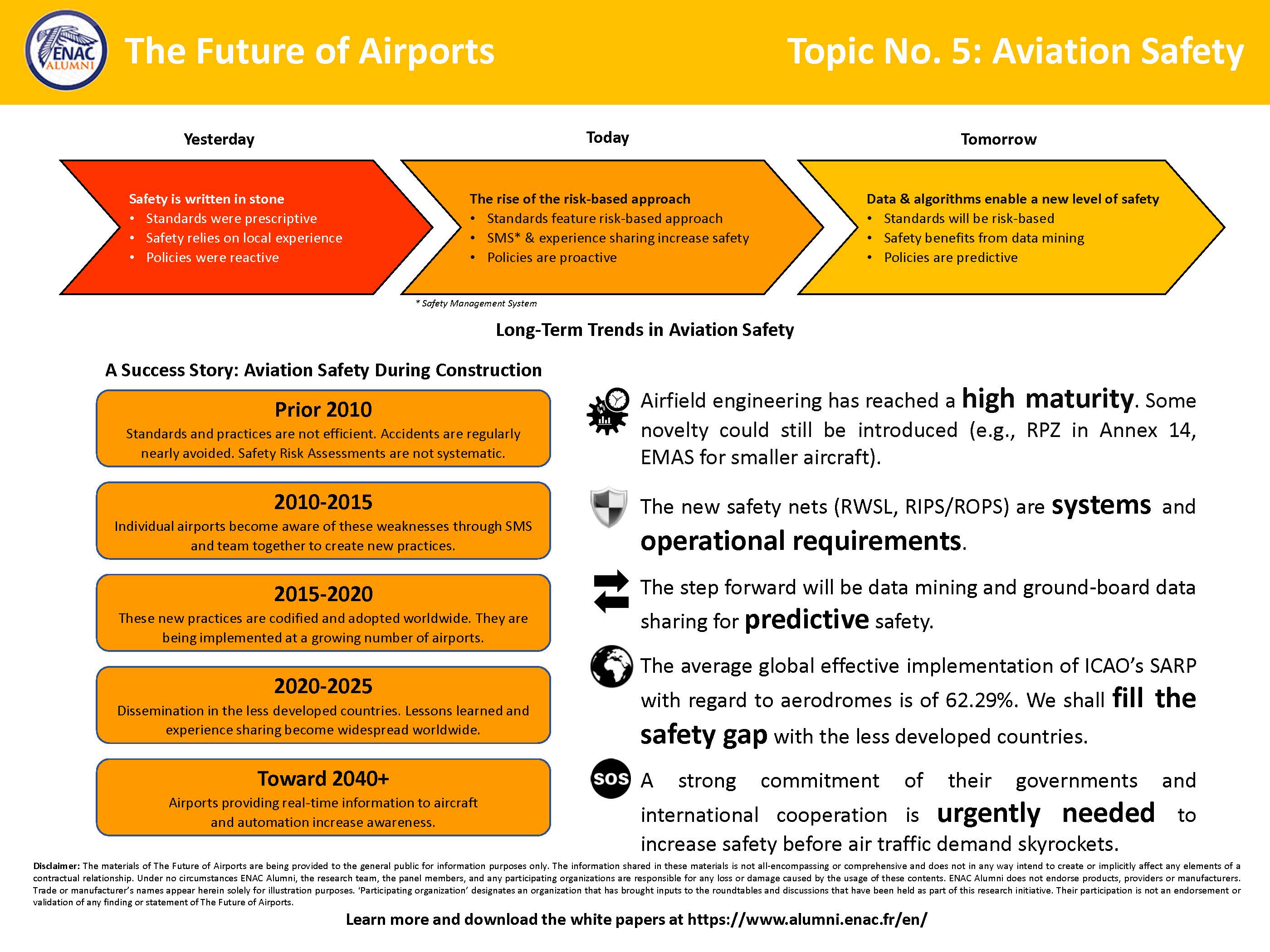 Generally speaking, the number of fatalities per revenue passenger kilometers (RPK) has decreased quasi-continuously since the years 1970. However, this function has a logarithm-like shape – which means that it is becoming increasingly difficult with our current conception of safety to reduce fatalities as we are improving safety overall. Over the second half of the 20th century, standards in airfield design were mainly conservative and prescriptive. The progress of the overall knowledge in flight control and airport engineering bolstered by the need for accommodating larger aircraft at existing infrastructure showed these standards were often overestimating risks and sometimes underestimating them. These efforts fostered a mutual understanding of the stakeholders of airfield design and certification – airport operators, aircraft manufacturers, and civil aviation authorities. More importantly, this created a momentum in safety and regulations that enabled the emergence and rise of the risk-based approach.
Generally speaking, the number of fatalities per revenue passenger kilometers (RPK) has decreased quasi-continuously since the years 1970. However, this function has a logarithm-like shape – which means that it is becoming increasingly difficult with our current conception of safety to reduce fatalities as we are improving safety overall. Over the second half of the 20th century, standards in airfield design were mainly conservative and prescriptive. The progress of the overall knowledge in flight control and airport engineering bolstered by the need for accommodating larger aircraft at existing infrastructure showed these standards were often overestimating risks and sometimes underestimating them. These efforts fostered a mutual understanding of the stakeholders of airfield design and certification – airport operators, aircraft manufacturers, and civil aviation authorities. More importantly, this created a momentum in safety and regulations that enabled the emergence and rise of the risk-based approach.
We have already developed most of the infrastructure enhancements possible for ensuring aviation safety at airports. “Hardware” design standards have reached an exceptional maturity. Mitigations were developed for addressing the most impactful deviations to these standards. Safety Management System (SMS) is a systemic and systematic vision of safety that was adopted by the ICAO in 2004. While some countries are still in the process of implementing it at airports, it is now a well-accepted international standard that has significantly contributed to the advancement of operational safety – including on the traffic and non-movement areas with the inclusion of ramp safety and ground handling. SMS has helped to bring together the stakeholders of airport operations at individual airports to build a joint ambition in aviation safety.
The next frontier to improve safety standards is made of real-time systems and data. Data sharing and real-time analysis of these data will increase both operational performance and safety. For example, the lack of safety data available have prevented airport safety risk analyses from being as quantitative and comprehensive as they should be, and National Aviation Authorities to get a detailed vision of safety issues – a condition for designing an efficient State Safety Programme (SSP). A more systematic reporting of accidents and incidents, and the centralization of these data, start helping airports and agencies to get this vision and utilize data to improve safety in complement of lessons learned directly from the field.
The next step may not be based of ground equipment. The future of airside safety also resides in cockpit equipment such as Runway Incursion Prevention Systems (RIPS), aircraft-ground data exchange, and the use of big data. Several cockpits already navigate airfields with the assistance of dynamic digital aerodrome charts. With in-flight updates, these charts could include the latest aeronautical information published by airports, provide enhanced guidance information during taxiing, and raise awareness and generate alerts on airfield safety issues such as runway incursions and wingspan restrictions.
It is vital to acknowledge that the level of safety is not the same throughout the world. Airports and oversight authorities shall work at closing the gap on ICAO standards. They should be inspired by the recommended practices as well to champion safety. Moreover, they shall become aware of their local specificities and gaps, and work on addressing them timely. The ICAO Global Aviation Safety Plan (GASP) is calling for such effort worldwide. The previous plan fell short in bringing all states up to the target on effective oversight implementation by 2017. The ongoing plan aims at getting each country to define and implement a State Safety Program (SSP). It is expected that the next period to the 2028 horizon focuses on implementing advanced safety oversight systems, including predictive risk management – a step that the most advanced countries have already achieved.
As of today, the Universal Safety Oversight Audit Programme (USOAP) reveals that the average global effective implementation of ICAO’s standards and recommended practices (SARP) with regard to aerodromes is of 62.29%. Considering the items at stake, this is a poor performance – and it is one of the lowest implementation rates of all the USOAP domains. Airports and the other stakeholders of flight operations need strong National Aviation Authorities to support national industries and ensure the safety of the overall air transportation ecosystem. In the less performant regions, a safety revolution is urgently needed to safeguard passengers and aviation assets. Beyond compliance with ICAO standards on oversight, each segment of the air transportation system shall comply with international standards and best practices, and a safety culture shall develop inside the aviation community, from the field to the executive management and governments.
Beyond the needs in infrastructure and equipment (“hardware”), a strong airport safety culture shall emerge within the airport staff and among the stakeholders (“software”). It should take into consideration the human and organizational aspects of safety. It shall be supported by the top management, embraced by the field, enable bottom-up reporting, be transverse throughout the airport organization, include the stakeholders as well. It means providing adequate means and training to the acting staff, and ultimately implementing Safety Management Systems (SMS). It also means fostering a safety culture based on transparency, non-punitive reporting, lessons learned and risk management.
![]() Topic No. 6: Airside and Airspace Compatibility
Topic No. 6: Airside and Airspace Compatibility
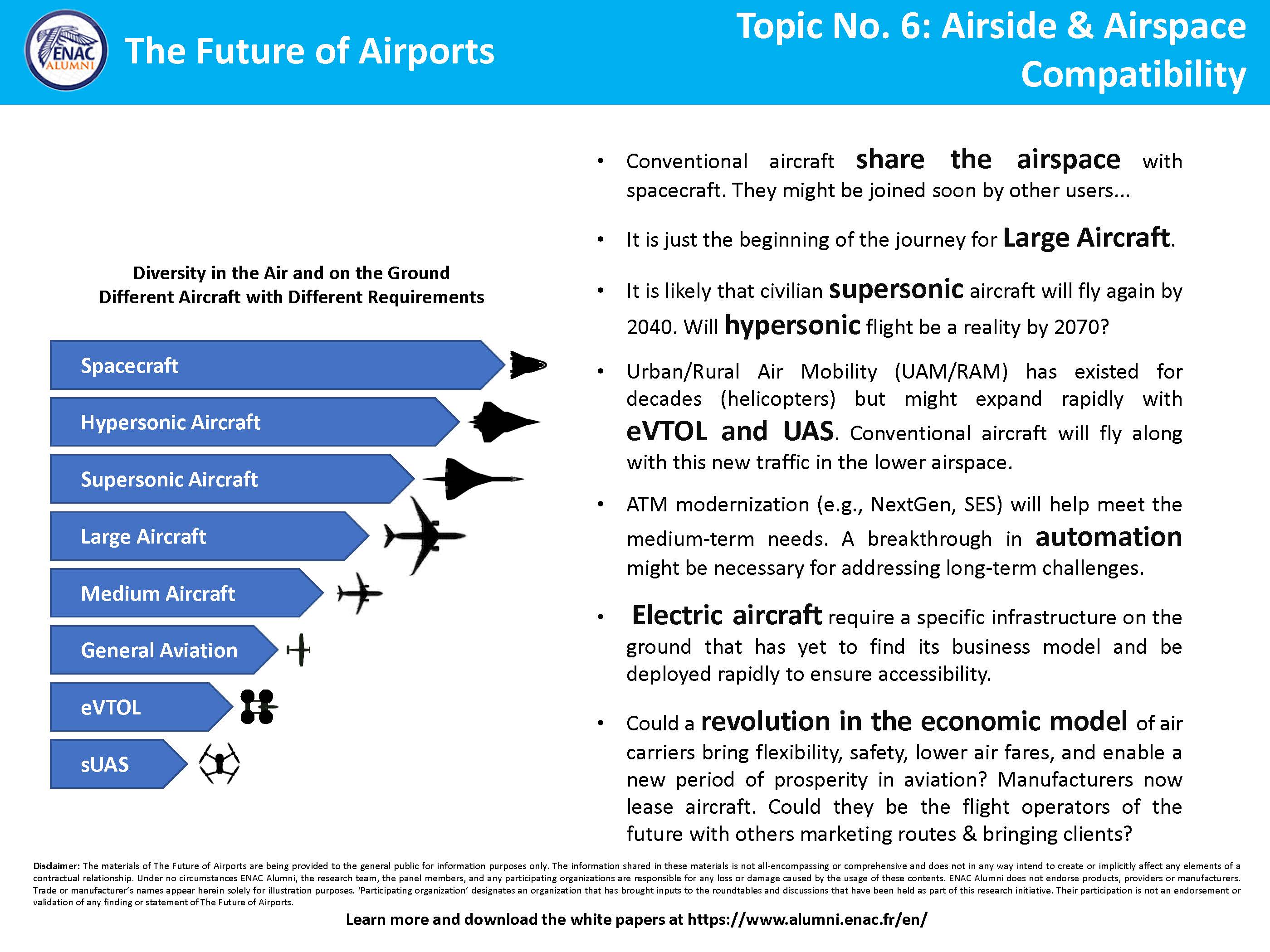 The fleet of aircraft in the field and in the air will become more diverse over the coming decades. The lower airspace might get busier in the coming 5 to 10 years. Urban and Rural (or Regional) Air Mobility (UAM/RAM) promises a new era of mobility with new vehicles that should be safer, cheaper, quieter and greener than today’s helicopters. Upon getting clearance from the regulators, they might enable an increase in capacity on intra- and perhaps inter-urban trips that are much needed in dense metropolitan areas with acute congestion issues. Urban Air Mobility will be provided by electric Vertical Takeoff and Landing (eVTOL) vehicles of various sizes moving 2 to 6 passengers or light freight. Services will include air taxi by manned electric helicopters and parcel deliveries by small Unmanned Aerial Systems (sUAS).
The fleet of aircraft in the field and in the air will become more diverse over the coming decades. The lower airspace might get busier in the coming 5 to 10 years. Urban and Rural (or Regional) Air Mobility (UAM/RAM) promises a new era of mobility with new vehicles that should be safer, cheaper, quieter and greener than today’s helicopters. Upon getting clearance from the regulators, they might enable an increase in capacity on intra- and perhaps inter-urban trips that are much needed in dense metropolitan areas with acute congestion issues. Urban Air Mobility will be provided by electric Vertical Takeoff and Landing (eVTOL) vehicles of various sizes moving 2 to 6 passengers or light freight. Services will include air taxi by manned electric helicopters and parcel deliveries by small Unmanned Aerial Systems (sUAS).
High-speed rotorcraft as tiltrotor or helicopters equipped with propulsive engines are at the horizon as well and will complete the VTOL offer with higher flight performances. Although they might occupy a smaller portion of the civilian rotorcraft market and will have higher operating costs than eVTOL vehicles, they could be of interest for applications where speed is a key factor for the success of the mission such as medical air transportation, law enforcement, some air taxis, and offshore services.
Electric aircraft is a broad category of aerial vehicles that include fixed-wing aircraft powered by electric engines. Several prototypes have been flying and the first commuter aircraft retrofitted with an electric engine flew in December 2019. Electric aircraft have promising applications for general aviation, commuter services and regional aviation. It might become a commercial reality during the 2020 decade. The feasibility of powering larger commercial aircraft with electric engines is not yet clearly established. Instead, larger aircraft might have hybrid propulsion systems electrically assisted during the cruise for lowering the consumption.
Older and smaller single-aisle aircraft are being replaced by jets of more advanced design such as the Airbus A220, Embraer E-Jet E2, and Mitsubishi SpaceJet. These single-aisle aircraft are now being used for international services and open new opportunities for small and medium hub airports. The A321LR and XLR will soon be flying long-haul routes formerly reserved to middle-of-the-market aircraft. These trends mean that terminal facilities and aprons shall be more versatile than before and be compatible with a more diverse fleet.
The termination of the production of the A380-800 announced for 2021 is not the end of the Large Aircraft (LA). The Airbus A380 and Boeing 747-8 might still be operating commercial services at the 2040 horizon. The next generation of large and long aircraft is already here with the A350-1000 and 777-9. The growth of the worldwide population, the emergence of new megalopolis with a strong middle class, and the scarcity of airside/airspace capacity make the case for the “jumbo” aircraft.
Supersonic aircraft will likely be back in the air by 2040. Nearly 20 years after the last flight of Concorde, at least 3 projects driven by U.S. start-ups have clean-sheet concepts for small supersonic jets either for commercial service or business aviation. While an entry into service (EIS) before 2025 as announced by these firms seem ambitious, demonstrators from Boom and NASA should be flying as early as 2021. New standards will be needed to regulate the emissions and noise of these aircraft. The comeback of civilian supersonic flight should not hinder the effort made by the industry to reduce the environmental footprint of aviation.
A hypersonic civilian market could emerge at the 2070 horizon. The idea of using hypersonic aircraft, gliders, or rockets for providing very long-range mobility is not new and was first proposed at the end of World War II. The development of new technologies, materials and manufacturing processes could make them available to civil aviation for commercial services or corporate aviation. SpaceX has suggested that its reusable Starship under development could be used for flying intercontinental routes – such as New York City to Shanghai in less than 40 minutes.
What if airlines themselves break between flight operators providing ready aircraft and holding the air operator certificate, and mobility providers developing the commercial offer and selling tickets? These charters of a new genre could both help to leverage growth in booming regions where flight operators have yet to become safer and reintroduce more diversity on mature markets. These flight operators could actually be the aircraft manufacturer themselves – they already train pilots and lease aircraft. Agreements between the parties of these “compound airlines” that could easily be recomposed and adapt to the evolutions of the demand could be facilitated by a new generation of contracts and certificates powered by blockchain technologies.
![]() Topic No. 7: Passenger Terminals and Customer Experience
Topic No. 7: Passenger Terminals and Customer Experience
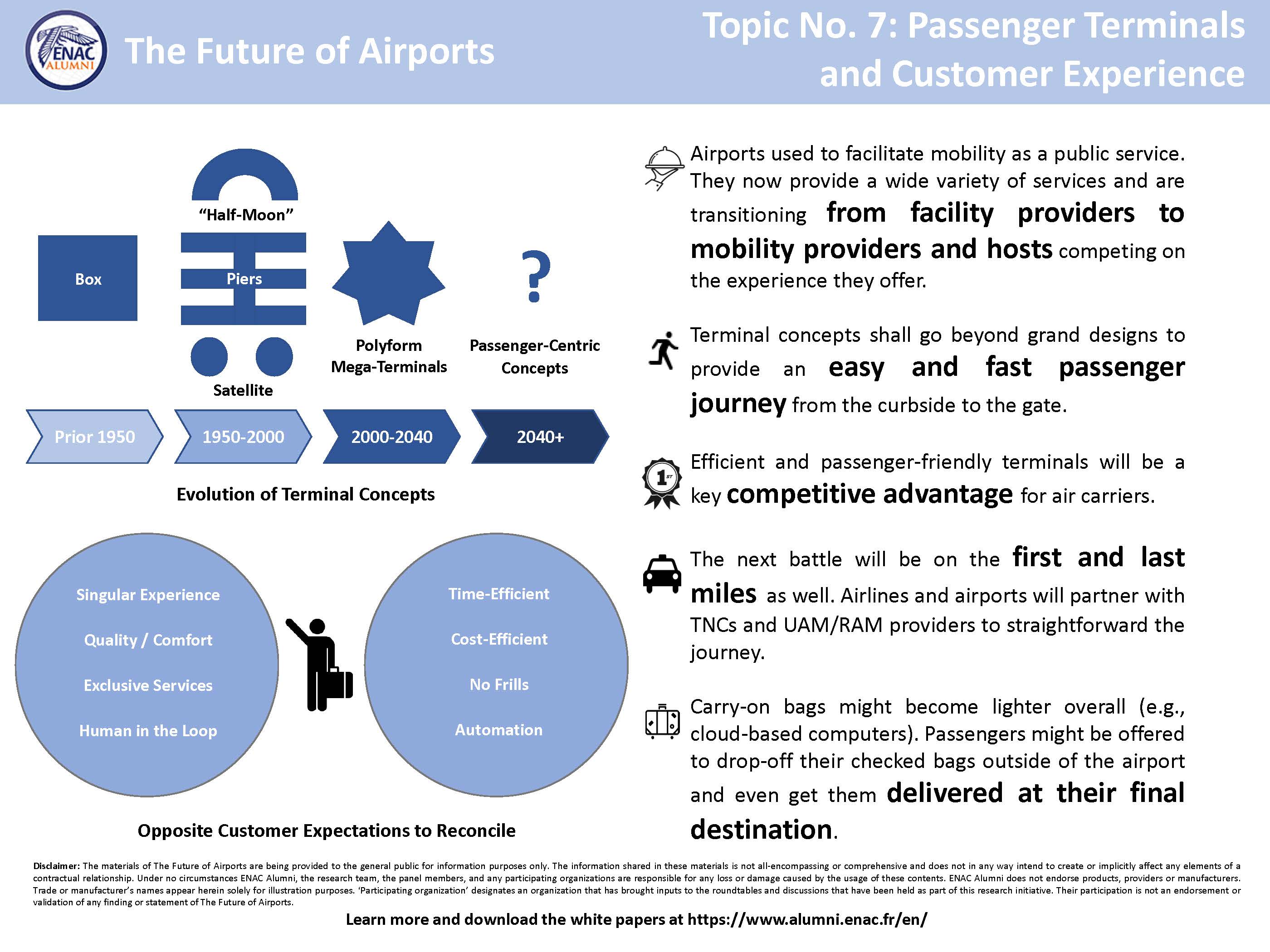 Airport operators used to be infrastructure managers providing aviation facilities as a public service. As their vision is now more passenger-centric, airport operators consider the passengers as their clients and might sometimes even compete with air carriers on providing specific services to them. The missions of airport operators are being transformed as they are transitioning from facility providers to mobility providers and hosts competing on the experience they offer.
Airport operators used to be infrastructure managers providing aviation facilities as a public service. As their vision is now more passenger-centric, airport operators consider the passengers as their clients and might sometimes even compete with air carriers on providing specific services to them. The missions of airport operators are being transformed as they are transitioning from facility providers to mobility providers and hosts competing on the experience they offer.
They develop services to passengers that may not all be commercially viable but have an overall positive impact on customer satisfaction. Innovative services include free lounge to connecting travelers, entertainment nearby the holdrooms, concerts and exhibitions, lactation rooms, water stations to replenish bottles, and even yoga rooms. Some of them, like the in-airport hotels, can be a competitive edge and a source of revenues as well. Airport retail and concessions are another key to generate substantial ancillary revenues. These retail spaces are part of the experience itself.
The newest, largest passenger terminal facilities have a polyform and centralized layout that can accommodate several dozens of million annual passengers under one single roof. The gigantism should not hinder the customer experience, operational efficiency, and resilience. Future concepts shall also achieve simplicity and modularity – and this is not necessarily a question of shape or configuration of the building only. Passenger facilities shall go beyond grand architectural designs and get back to the roots of terminal design: providing a straightforward, seamless, and pleasant access to the aircraft from the curbside. There is a race to the biggest “cathedral-terminal” building between mega-hub airports. But we shall not forget that many passengers just want to get from their car or mass transit system to the gate, or from the gate to the gate for short connections.
Modularity should be another function achieved by future terminals. While air transportation has been experiencing strong long-term growth, air traffic is also highly sensitive to temporary economic turndowns that can lead to quick market transformations such as airline consolidations and strategic decisions with impactful decisions for airports, from a network restructuring to more dramatic reductions of the number of airline hubs. The past decade has seen emerged other novelties such as low-cost, long-range air carriers, single-aisle aircraft being used on long-haul routes that call for more agile passenger facilities that can handle fairly dynamically larger and smaller aircraft, and domestic and international passengers. Geopolitical changes and disruptive events changing standards and practices are other conundrums for airports. The information and intelligence technologies might ultimately influence how space and resources are used and change the main ratios and reference values used by the industry for planning and design.
In the end, getting the basics right is as important as creating a “wow” effect. The top priority of a passenger is either locating the departure gate or recovering his bag and securing a ride to arrive on time to the final destination. Applications and services may alleviate this mental load, improve the experience, and perhaps increase ancillary revenues. But simplicity does not mean low-cost. No-frills terminals show their limits as they do not achieve passengers’ expectations. It might be a difficult paradigm to address for some airport operators that need funds to maintain or upgrade their facilities while facing a strong opposition of air carriers to collect adequate user fees to do so.
Efficient and passenger-friendly terminals will be a key competitive advantage for air carriers. Individual carriers and wider alliances are spending a large amount of money modernizing terminal facilities and customizing them to offer a consistent high-end experience from airport to airport. The next competition will be on the first and last miles – from the door to the curbside. Airlines and airports might team or at least better coordinate with transportation network companies to simplify this part of the trip. It is already possible in some cities to check-in bags at hotels or the train station to the airport. Additional services will be proposed, such as the baggage pickup and delivery at home or the workplace.
![]() Topic No. 8: Operational Performance and Resilience
Topic No. 8: Operational Performance and Resilience
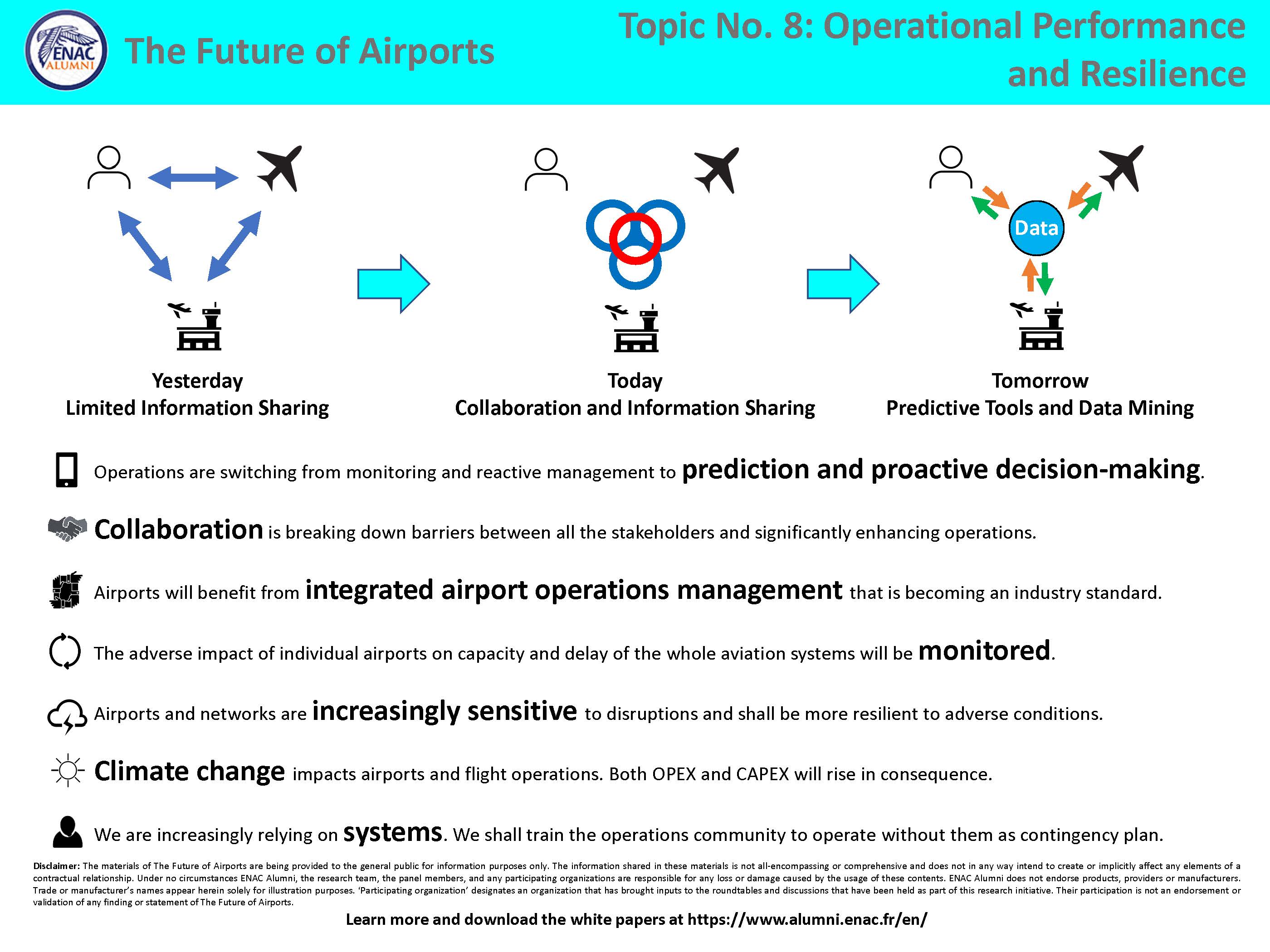 Airports and aviation systems are complex ecosystems that support a global economy and provide for the safe and efficient movement of passengers and cargo. While crises such as the Great Recession and the COVID-19 pandemic have short-term adverse effects, air traffic has a proven long-term resilience that leads forecasters to predict a world annual growth rate of at least 4.5% to the 2040 horizon. Enhancing the accommodation of this growing throughput with improving punctuality and resilience has been one of the main concerns of the air traffic management modernization effort that the world has undertaken under the umbrella of the International Civil Aviation Organisation’s (ICAO) Global Air Navigation Plan (GANP).
Airports and aviation systems are complex ecosystems that support a global economy and provide for the safe and efficient movement of passengers and cargo. While crises such as the Great Recession and the COVID-19 pandemic have short-term adverse effects, air traffic has a proven long-term resilience that leads forecasters to predict a world annual growth rate of at least 4.5% to the 2040 horizon. Enhancing the accommodation of this growing throughput with improving punctuality and resilience has been one of the main concerns of the air traffic management modernization effort that the world has undertaken under the umbrella of the International Civil Aviation Organisation’s (ICAO) Global Air Navigation Plan (GANP).
Collaboration between the stakeholders of real-time operations has been a game changer everywhere it has been implemented. The different organizations representing all the stakeholders of airport operations have called for the end of the “silo effect” and have supported Airport Collaborative Decision-Making (A-CDM). The benefits of collaboration are tremendous. A 2016 assessment by EUROCONTROL shows that across 17 CDM airports in Europe, ATFM delay has been reduced by 10.3%, the average taxi-time by 7%, and the fuel consumption, CO2 and SO2 emissions by 7.7%. Europe and the United States have pioneered Collaborative Decision-Making.
The step forward will be predictive management. Advanced collaboration has made available a large quantity of flight operations data collected into Airport Operations Databases (AODB) and other repositories. Processing these data through intelligent systems and organizations to predict potential disruptions, triggering preventive actions before it happens, and eventually mitigating their effect is now becoming possible. Moreover, this predictive management approach might be the next step in the advancement of airport and air navigation management while major modernization programs such as SESAR and NextGen are coming to an end, and the ICAO GANP itself does not provide a framework for the period beyond 2030 yet.
Resilience starts on the first day of operations of a new facility with the Operational Readiness and Airport Transfer (ORAT) process. The commissioning of a new facility can be challenging, especially when a massive capacity is being delivered at the same time such as the new Beijing Daxing International Airport (PKX) and Istanbul Airport (IST). Architects, designers, and engineers shall keep in mind that innovation shall ultimately serve the operations. The first intelligence systems in aviation are the aviation professionals. Airports shall be easy to maintain and operate. Too many architectural features master the art of making the task of the operating staff impossible. Changing a light fixture shall never require custom-made equipment. Mechanical, electrical, and plumbing (MEP) systems shall be accessible to maintenance teams. An airport is a masterpiece only if it looks beautiful and operates efficiently at the same time.
Climate change raises specific threats to resilience. Its effects on our infrastructure systems are already visible in 2020. Significant climate anomalies with a direct impact on our lives have now been recorded for over two decades. They range from frequent record high temperatures to violent winter storms, and they have direct consequences on the health and availability of airport assets and both the operating and capital expenditures. Some of these events have been creating new paradigms regionally.
Beyond the extreme weather conditions, the overall climate is evolving. According to a study by a team of ETH Zürich researchers, the 2050 climate in London will be more similar to the current one in Barcelona. Seattle might experience conditions closer to today’s San Francisco. Nairobi might feel like Maputo, and Tokyo like Changsha. Such changes will redefine critical criteria for airport design and operations such as the 100-year floodplain, the average temperature, or the windrose.
![]() Topic No. 9: Communities and Mobility
Topic No. 9: Communities and Mobility
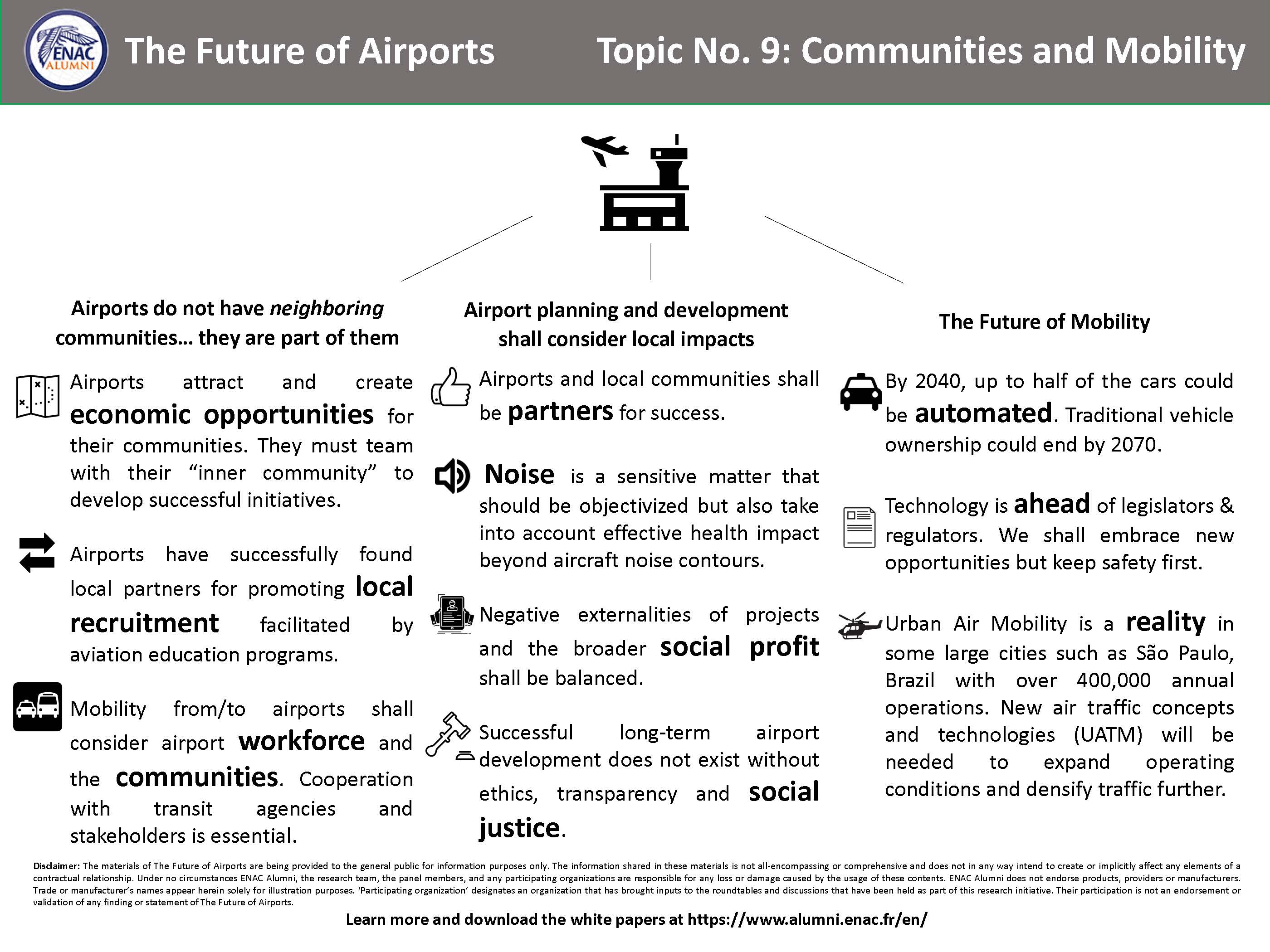 Airports do not have “surrounding” or “neighboring” communities. They are part of and a member of these communities. Airport communities can take different forms and meaning even at a single airport, depending on the matter. For the purpose of this discussion, we defined the concepts of inner and outer communities. The inner community, in the direct vicinity of the airport, is exposed to specific, direct economic benefits but also negative externalities (higher noise exposure). The inner community includes cities where the airport is sitting on, and adjacent ones turned toward the airport because they depend on it economically or are directly exposed to its externalities. A key attention from the airport should be seeking a peaceful and mutually beneficial coexistence with its “neighbors”. This could be achieved by helping them insulate homes and workplaces against noise when relevant and developing an adequate land use plan for allowing a fair and balanced development. The outer community is served by the airport and may encompass its primary catchment area to include the macro-region. The outer community encompasses a large diversity of parties benefiting from or concerned by the airport. This includes local passengers flying their community airport, business and economic development community looking for a dynamic airport supporting them with more direct flights, local governments, and various agencies involved with the wide range of airport-related challenges and opportunities, etc. Its footprint could include the metropolitan area and a broader region, depending on the aspects considered. Large hub airports are gateways for entire regions and countries. Airports in remote and scarcely populated areas enable opportunities for vast territories.
Airports do not have “surrounding” or “neighboring” communities. They are part of and a member of these communities. Airport communities can take different forms and meaning even at a single airport, depending on the matter. For the purpose of this discussion, we defined the concepts of inner and outer communities. The inner community, in the direct vicinity of the airport, is exposed to specific, direct economic benefits but also negative externalities (higher noise exposure). The inner community includes cities where the airport is sitting on, and adjacent ones turned toward the airport because they depend on it economically or are directly exposed to its externalities. A key attention from the airport should be seeking a peaceful and mutually beneficial coexistence with its “neighbors”. This could be achieved by helping them insulate homes and workplaces against noise when relevant and developing an adequate land use plan for allowing a fair and balanced development. The outer community is served by the airport and may encompass its primary catchment area to include the macro-region. The outer community encompasses a large diversity of parties benefiting from or concerned by the airport. This includes local passengers flying their community airport, business and economic development community looking for a dynamic airport supporting them with more direct flights, local governments, and various agencies involved with the wide range of airport-related challenges and opportunities, etc. Its footprint could include the metropolitan area and a broader region, depending on the aspects considered. Large hub airports are gateways for entire regions and countries. Airports in remote and scarcely populated areas enable opportunities for vast territories.
The inner community of the future should be connected to and supported by its airport. Adverse impacts and in particular noise must be better taken into considerations in countries where land-use policies and insulation programs are not yet in place or enforced. But community issues go beyond the noise and pollution aspects that are developed further in Topic No. 10. Accessibility around an airport can be paradoxically an issue when all ground transportation is directed toward the airport and designed for draining passengers to other centers of residence, consumption, and decision. Airports increasingly promote a recruitment in their inner communities for fostering the integration of their population, reducing unemployment and providing opportunities for social mobility, and growing an airport-centric community. In return, a dynamic inner community can develop a whole ecosystem of small businesses that can ultimately be connected to airport-based activities and an airport trade center that will be served by various local services. However, several airports around the world have residential areas in their immediate vicinity. They are often inhabited by lower income households – and voiceless communities in some parts of the world. Sometimes, these communities relocate around airports pushed away from their original settlements because of uncontrolled gentrification without the social justice component. Climate gentrification is an emerging issue that might make this phenomenon more severe. At the same time, the same lands around airports might become the target of industrial or business real-estate developers. This calls for a special attention to social justice in planning and development.
One of the main challenges of the 2040 and 2070 horizons for airports serving large outer communities will be mobility. Virtually all major metropolitan areas are facing some kind of acute congestion symptoms. Moscow, Istanbul, Bogota, Mexico City, São Paulo, London, Rio de Janeiro, Boston, Los Angeles, Roma are among the worst cities in the world for the average accrued number of hours spent sitting in traffic annually. Accessibility has a direct impact on the attractiveness of airports as both transportation mode and workplace. We are at the edge of a revolution in urban mobility, and airports shall embrace it in order to increase their attractiveness and their connectivity to their communities. Mass transit is being implemented in new cities, including countries that have been historically reluctant to fund public transportation systems. Maybe closer to us than it might appear, automated and connected vehicles (AV/CV) will unlock new perspectives with widely available and accessible low-cost ridesharing that could even replace individual car ownership at some point. However, as AV/CV could optimize the utilization of roads through network coordination using artificial intelligence, they will not provide a relief to existing congestion as they share the ground-level resource available with existing modes and vehicles. AV/CV will replace or add vehicles to the existing traffic. If they are highly affordable, the AV/CV-based TNC offer might even seduce current users of mass transit, take revenues out of public transportation, and worsen congestion issues. We have to rethink mobility and think out of the box to develop new capacities that are complementary to existing modes. In large cities that already have such systems but are still facing acute congestion issues, innovative modes are emerging. With the resource being scarce at ground level, they explore options underground and in the air. Urban Air Mobility (UAM) is promising as well for providing point to point connections from the airport. In large metropolitan areas, the future is most likely a combination of existing and new urban mobility solutions – like it is often already the case – to address the demand.
![]() Topic No. 10: Sustainability and Airport-Citizens
Topic No. 10: Sustainability and Airport-Citizens
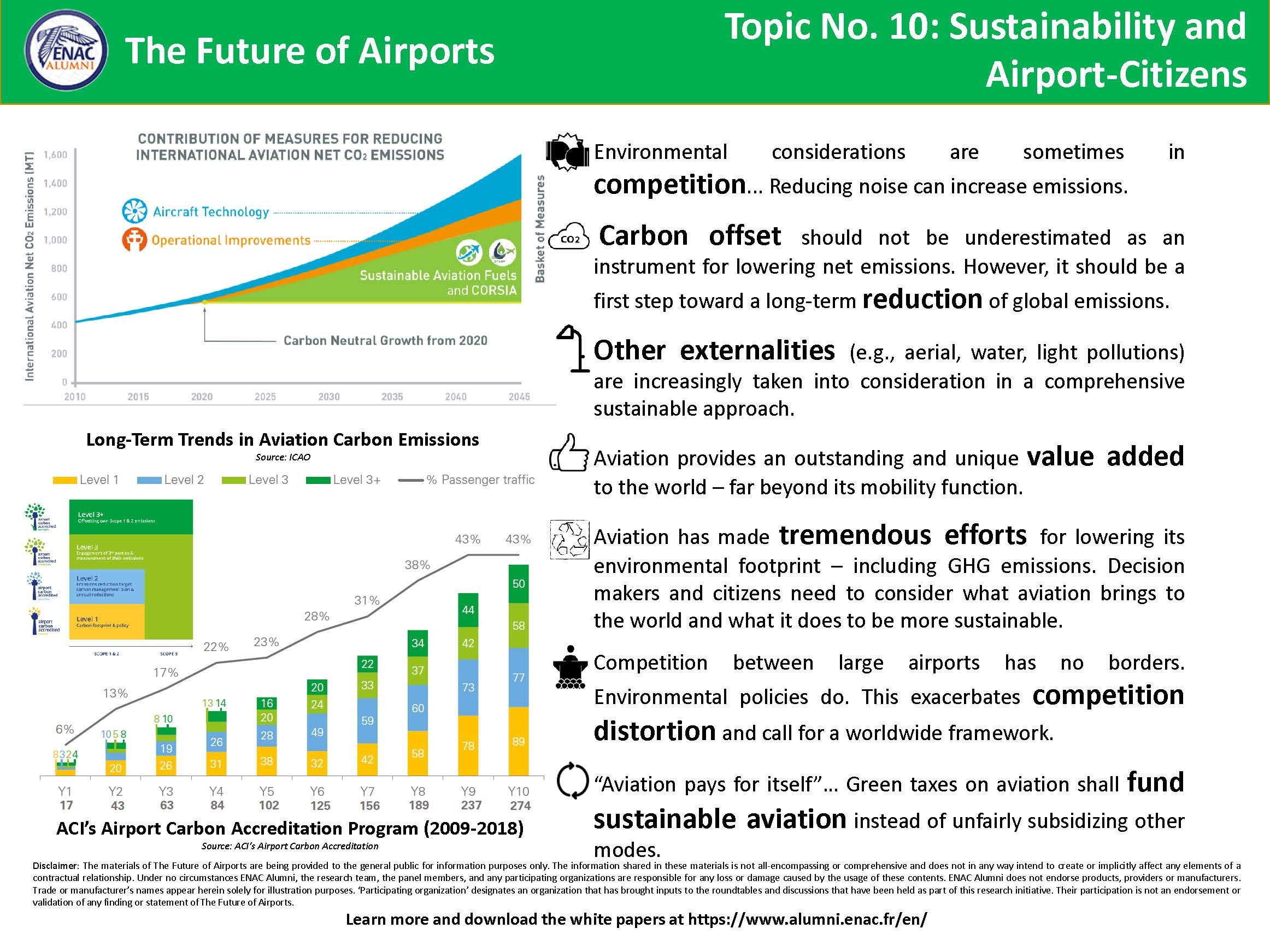 Like any human activity, air transportation has negative externalities. Aircraft noise has been the first airport-related issue to be recognized as so. Programs and activities aiming at reducing the number of people affected by noise have had significant effects since the 1970s in several countries. However, according to ICAO, the footprint of the 55 dB DNL noise contour from 315 commercial service airports representing 80% of the global traffic could double if no progress is made on aircraft technology. The 2015 footprint represents 14,400 km2 and 30 million people. Advanced but achievable technological improvement could stabilize this accrued noise exposure to its 2015 level and even reduce it. While the aircraft and engine design industries are working on such improvements, airports and governments also have a strong role to play for reducing this footprint, enhancing the insulation of the most exposed homes, and lowering the number of residents within this contour on the long-term. ICAO's standards and recommended practices (SARPs) on aircraft noise at airports include the framework for aircraft type noise certification. It also includes the guidance developed through the “Balanced Approach to aircraft noise management” (Doc 9829). This Balanced Approach analysis is specific to each airport geography, traffic, and conditions and a social and economic analysis must be undertaken for each measure envisaged. Aerial pollution (e.g. NOx and particles) and greenhouse emissions (e.g., carbon dioxide) are the main types of gaseous externalities of an airport. Airports shall have a holistic vision of these emissions when preparing a sustainable plan. They should include the emissions of aircraft, ground handling services, passenger terminals and support facilities, landside facilities, but also ground transportation from and to the airport for passengers and airport workers, and emissions of their supply chain as well.
Like any human activity, air transportation has negative externalities. Aircraft noise has been the first airport-related issue to be recognized as so. Programs and activities aiming at reducing the number of people affected by noise have had significant effects since the 1970s in several countries. However, according to ICAO, the footprint of the 55 dB DNL noise contour from 315 commercial service airports representing 80% of the global traffic could double if no progress is made on aircraft technology. The 2015 footprint represents 14,400 km2 and 30 million people. Advanced but achievable technological improvement could stabilize this accrued noise exposure to its 2015 level and even reduce it. While the aircraft and engine design industries are working on such improvements, airports and governments also have a strong role to play for reducing this footprint, enhancing the insulation of the most exposed homes, and lowering the number of residents within this contour on the long-term. ICAO's standards and recommended practices (SARPs) on aircraft noise at airports include the framework for aircraft type noise certification. It also includes the guidance developed through the “Balanced Approach to aircraft noise management” (Doc 9829). This Balanced Approach analysis is specific to each airport geography, traffic, and conditions and a social and economic analysis must be undertaken for each measure envisaged. Aerial pollution (e.g. NOx and particles) and greenhouse emissions (e.g., carbon dioxide) are the main types of gaseous externalities of an airport. Airports shall have a holistic vision of these emissions when preparing a sustainable plan. They should include the emissions of aircraft, ground handling services, passenger terminals and support facilities, landside facilities, but also ground transportation from and to the airport for passengers and airport workers, and emissions of their supply chain as well.
Aviation is essential to our modern, globalized economy. Aviation supports most of the 17 Sustainable Development Goals (SDGs), developed by the United Nations in 2015. A comprehensive study was developed by the Air Transport Action Group (ATAG) in 2017. Airports make a massive contribution to the economic welfare of regions. They are centers of direct and indirect employment: personnel employed by airport operators directly and by other entities at the airport represent more than 6.1 million jobs globally. Airports trigger large investments for maintaining and developing their infrastructure that lead to further local jobs. It enables a broad range of opportunities and widens the horizon of possibilities, attracting businesses, residents and tourists. Airports create high speed mobility options between cities, regions, and countries offering direct connections to the world for manufacturers and investors. Aviation does not benefit to large corporations only. It creates new opportunities for small local producers. Tourism has been a powerful economic contributor and development driver for many regions and countries all over the world. More than half of the international tourists travel by air. In 2001, 72% of tourists visiting Costa Rica arrived by plane. While the country has pledged to shutdown mineral extraction, stop deforestation, and focus on more sustainable resources such as responsible tourism, air transportation is a necessity to achieve these goals. Airports provide mobility to remote or scarcely populated areas. Humanitarian aid and search and rescue missions need aviation facilities to support their operations as well. In remote areas and across vast territories, connectivity provided by air transport can be more sustainable than if ground infrastructure were built. For many insular countries and overseas territories, air transportation is the only means to connect to the world and to move passengers and goods from island to island in a timely manner.
The impact of airports – and aviation as a whole – on climate change have been taken into consideration for decades. Aviation accounts for about 2% of the worldwide CO2 emissions, a constant share since the early 1990s, even if the absolute emissions regularly increase due to the growing demand for air travel. Although CO2 is the only greenhouse gas (GHG) significantly emitted by aviation, other pollutants (NOx, fine particulates, etc.) are also emitted. Part of these emissions occur at high altitudes, which might increase its net impact according to models. However, there is still an uncertainty on the exact direct contribution of aviation to climate change due to the complexity of its chemistry. For instance, aviation NOx contribute to ozone generation (increasing the greenhouse effect) under certain conditions, and to methane depletion at other altitudes (reducing this same effect). Also, the impact of contrails and their ability to generate cirrus clouds have to be taken into consideration. The Airport Carbon Accreditation program of Airports Council International (ACI) is a global carbon management initiative that specifically targets airport emissions. The program has been endorsed by the ICAO since 2011. The initiative provides a framework for airports to reduce their carbon footprint through local green initiatives as well as carbon offsetting in an objective to carbon neutrality. Several airports have already achieved the highest certification Level 4 – which implies carbon neutrality. The Airport Carbon Accreditation and carbon offset as a way to reduce the footprint of individual airports should not be underestimated – as should not be ICAO’s Carbon Offsetting and Reduction Scheme for International Aviation (CORSIA). At the same time, it is just a first step toward greener airports. Comprehensive decarbonization of airports will require the reduction and, as far as practicable, the elimination of emissions at the source.
![]() Topic No. 11: Human Resources and Education
Topic No. 11: Human Resources and Education
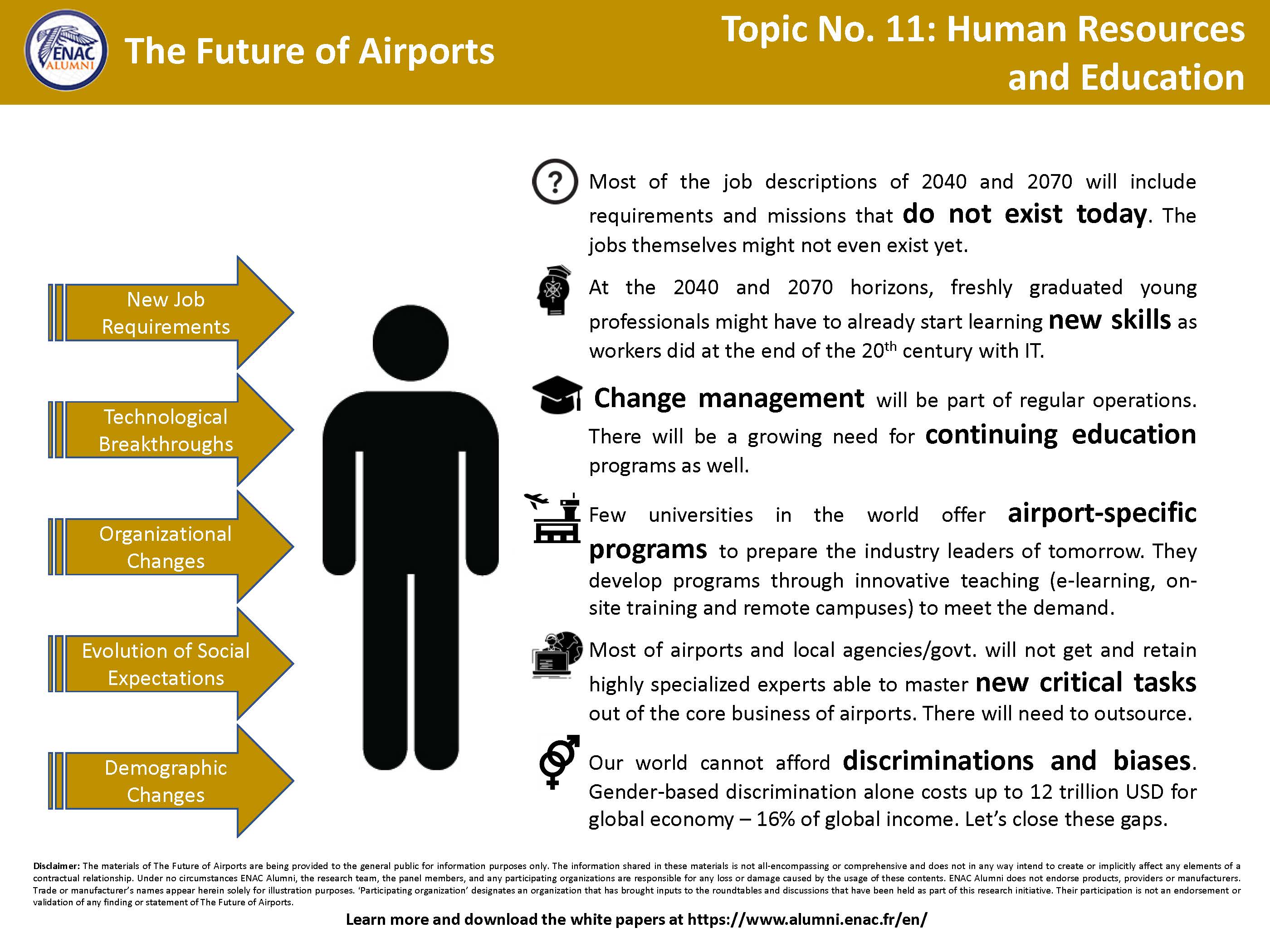 Most of the job descriptions of 2040 and 2070 will include requirements and missions that do not exist today. 50 years or even 20 years ago, airports had no Community Manager or Safety Manager. They are now essential functions in modern airports. Technology is a big driver as well. For instance, Airport GIS created jobs and has proven itself to be an invaluable tool for others with applications from asset management to aeronautical information. Many vital jobs of the 2040 and 2070 horizons do not exist yet. Moreover, we might not even be able to imagine them. The workplace itself is changing. Part of the jobs can now be performed from remote locations – including home – with the same or higher productivity. But humans are social animals. They need to gather and share together. Well-being at work and a collaboration environment are keys to performance and efficiency. Being a “great place to work” is also important to attract and retain talents. Studies show that younger workers prefer having the option to work from home, but at the same time, they want a higher level of interaction with their coworkers and their management. The future cannot be about systems but about humans with more freedom and flexibility, interacting with each other and advancing at a faster pace thanks to the systems. Workers are increasingly giving importance to the values of their organization, the meaning of their work, the interaction with their management, the collaboration with their teammates and stakeholders, and the flexibility they can have in managing their daily routine.
Most of the job descriptions of 2040 and 2070 will include requirements and missions that do not exist today. 50 years or even 20 years ago, airports had no Community Manager or Safety Manager. They are now essential functions in modern airports. Technology is a big driver as well. For instance, Airport GIS created jobs and has proven itself to be an invaluable tool for others with applications from asset management to aeronautical information. Many vital jobs of the 2040 and 2070 horizons do not exist yet. Moreover, we might not even be able to imagine them. The workplace itself is changing. Part of the jobs can now be performed from remote locations – including home – with the same or higher productivity. But humans are social animals. They need to gather and share together. Well-being at work and a collaboration environment are keys to performance and efficiency. Being a “great place to work” is also important to attract and retain talents. Studies show that younger workers prefer having the option to work from home, but at the same time, they want a higher level of interaction with their coworkers and their management. The future cannot be about systems but about humans with more freedom and flexibility, interacting with each other and advancing at a faster pace thanks to the systems. Workers are increasingly giving importance to the values of their organization, the meaning of their work, the interaction with their management, the collaboration with their teammates and stakeholders, and the flexibility they can have in managing their daily routine.
As new technologies are constantly appearing and the succession of innovational breakthroughs is accelerating, we will need a new approach for change and knowledge management. Technological shocks similar to the first IT revolution that required generations to learn and transition to computers and information systems not so long ago will be more frequent. Freshly graduated young professionals might already have to start learning new vital skills shortly after leaving school. Organizations might have to adapt as well. Change management will be part of regular operations. Successful airports will identify these emerging changes early, evaluate their effects on existing conditions, and adapt their organization and train their staff. It would not be surprising to have full-time change manager positions at many airport and stakeholder organizations. The next big revolution might be another “IT” revolution with the emergence of intelligence technologies. We are at the threshold of the introduction of artificial intelligence and machine learning on a large scale. Thinking about this second IT revolution as a modification of the way we interact with existing electronic devices and systems is missing the point. This will open a broad field of completely new applications and systems that we can barely envision as of today. Some of them will assist human operators. Some others might even replace human decision-makers. It will create new needs for specialists able to develop and maintain these systems, make sure they interact adequately, and interpret their output – such as what-if scenarios – for final decision-making. This is going to deeply change our interactions with our world, including the way we move, communicate, enjoy, consume and work.
Gender-based discrimination alone costs up to 12 trillion USD for the global economy – 16% of the global income. Women are historically underrepresented among the transportation workforce, and victim of biases during their career. Because the world is our guest, we must reflect on the diversity of our clients and our communities to remain competitive and innovative. A diverse workforce and management are crucial for embracing and addressing the complexity of the challenges to come. Diversity is not limited to gender and ethnicity, but it includes and is not limited to age, sexual orientation, special needs, cultural background, socioeconomic status, and non-airport or aviation experience. Studies have shown the clear benefits of diversity in organizations. While the 20th century fell short in delivering expectations of freedom, justice, and progress for all, we must not let this 21st century follow the same path. Our world cannot afford discrimination and biases. They do not only go against the very fundamental values of aviation that are expressed in the Convention of Chicago on Civil Aviation and are reflected in our diverse clients and the workforce. They prevent talents from emerging, innovations from blooming, and opportunities from coming true. To address the challenges of 2040 and 2070, let’s close now these gaps and get rid of biases once for all.



